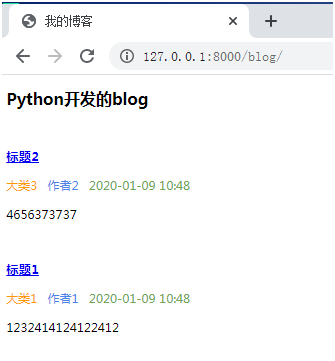主页是一个“博客列表”页。博客要按发布时间的倒序来排列,每个博客都要包含标题、作者、分类、发布时间的显示(年-月-日 时:分)及节选的正文内容(前 100 个字)。点击单独的博客可以进入其详情页。
1. 建立视图
将数据库中的数据按需求中所需的发布时间的倒序取出,然后构造模板,最终将结果返回给用户。
编辑blog/views.py
from django.shortcuts import render from .models import Blog, Comment def get_blogs(request): blog_list=Blog.objects.all().order_by('-created') return render(request, 'blog-list.html', {'blogs':blog_list})
或
from django.shortcuts import render from .models import Blog, Comment def get_blogs(request): ctx = { 'blogs': Blog.objects.all().order_by('-created') } return render(request, 'blog-list.html', ctx)
使用Django 的 ORM 对博客数据进行查询,并依发布时间的倒序进行排列,然后将结果集(一个 QuerySet 对象)放在一个字典对象 ctx 的 blogs 中。然后调用 render 方法来渲染模板,render第一个参数始终接收 request 对象,第二个参数是要渲染的模板文件,第三个参数则是可选的上下文参数。注意观察视图函数的入参,其第一个参数一定是 request 对象。
上面视图中用到模板文件blog-list.html,下面来建立。
2. 确定模板的位置
Myblog/settings中的TEMPLATES中修改模板路径
'DIRS': ['templates/'],
3. 建立首页模板blog-list.html
在项目根目录下新建templates 文件夹,里面新建一个blog-list.html 文件。
作为上下文传入的参数在模板中可以以变量的形式直接访问。这里对 blogs 进行了一次 for 迭代,然后为每一篇博客生成一个 div 容器供其展示。在 div 内部又通过变量属性的访问来获取诸如博客标题、分类名称、作者、正文和发布时间等内容。重点为for 循环:
{% for xx in xxs%}
HTML语句
{% endfor %}
博客标题以后是要做链接进入博客内容页面的,此处链接以”#”替代。
<!DOCTYPE html> <html lang="en"> <head> <meta charset="UTF-8"> <title>我的博客</title> <style> .blog { padding: 20px 0px; } .blog .info span { padding-right: 10px; } .blog .summary { padding-top: 20px; } </style> </head> <body> <div class="header"> <h2>Python开发的blog</h2> </div> {% for blog in blogs %} <div class="blog"> <div class="title"> <a href="{#}"><h3>{{ blog.title }}</h3></a> </div> <div class="info"> <span class="category" style="color: #ff9900;">{{ blog.category.name }}</span> <span class="author" style="color: #4a86e8">{{ blog.author }}</span> <span class="created" style="color: #6aa84f">{{ blog.created|date:"Y-m-d H:i" }}</span> </div> <div class="summary"> {{ blog.content|truncatewords:100 }} </div> </div> {% endfor %} </body> </html>
4. 修改路由myblog/urls.py
from django.contrib import admin
from django.urls import path
from blog.views import get_blogs
urlpatterns = [
path('admin/', admin.site.urls),
path('blog/',get_blogs,name='blog_get_blogs'),
]
5. 运行开发服务器
在manage.py所在的目录中执行命令:
python manage.py runserver
默认端口号8000,可在语句最后指定其他端口号。命令行窗口不能关闭。
